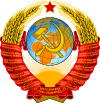
Back قادة الاتحاد السوفيتي Arabic ليستة حكام روسيا ARZ SSRİ liderlərinin siyahısı Azerbaijani Спіс кіраўнікоў СССР Byelorussian Списък на лидерите на СССР Bulgarian সোভিয়েত ইউনিয়নের প্রধান নেতা Bengali/Bangla Vođe Sovjetskog Saveza BS Seznam představitelů Sovětského svazu Czech Κατάλογος Ηγετών της Σοβιετικής Ένωσης Greek List of leaders of the Soviet Union English
| Leader of the Soviet Union
Лидер Советского Союза (Russian) | |
|---|---|
 | |
| Style | Mr. Leader (informal) His Excellency (diplomatic) |
| Type | Country leader (de facto) |
| Reports to | Supreme Soviet |
| Residence | Kremlin Senate, Moscow |
| Appointer | Supreme Soviet |
| Term length | None, Life tenure |
| Precursor | Tsar of Russia |
| Formation | 30 December 1922 |
| First holder | Vladimir Lenin |
| Final holder | Mikhail Gorbachev |
| Abolished | 26 December 1991 |
| Succession | President of Russia (de facto) |
| Deputy | None |
The leader of the Soviet Union (Russian: Лидер Советского Союза, romanised: Lider Sovetskogo Soyuza) was an informal term for the most important political figure in the Soviet Union. It was the de facto leader of the country. The leader controlled the Communist Party of the Soviet Union (CPSU) and the Red Army, often held the title of CPSU General Secretary.
The state representative, head of state (president) or head of government (premier) weren't always necessarily the leader as under the Soviet Union's party-state system, CPSU roles were politically more important than state titles. However, most of the Soviet leaders were also the president and premier. The leader was the most power title in the country as all of the individuals who held the position except Georgy Malenkov were the most powerful figures in the country.
